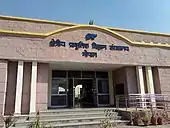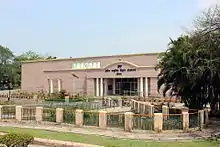Regional Museum of Natural History, Bhopal
Regional Museum of Natural History, Bhopal is a branch of the National Museum of Natural History, New Delhi, it is the center of an informal environment education, whose main purpose is to make people aware of environmental protection through various internal and external activities. It is located in the Environment Complex in Bhopal. The museum was inaugurated in the year 29 September 1997,[1] by the then Minister of Environment and Forests of India, Saifuddin Soz. The program was chaired by the then Chief Minister of Madhya Pradesh, Digvijaya Singh. The museum offers a unique opportunity to understand the biodiversity of Central India and the complex natural make-up surrounding it. In the galleries located in the museum, the exhibition has been displayed in collaboration with transcripts, translate and visual audio. Dioramas and phenomena are presented in the order of selected subjects. It also has a biology, computer and a research room meant for children to acquire knowledge in a fun way. A temporary exhibition site is also made in premises which exhibit organized displays on various subjects from time to time.[2] The museum is open daily from 10.00am to 6.00pm (except on Monday and national holidays) Upon entry to the museum, the exhibition of the family of Dinosaur, called Triceratops, is visible.
RMNH, Bhopal | |
 | |

| |
| Established | 29 September 1997 |
|---|---|
| Location | Paryavaran Parisar E-5, Arera Colony, Bhopal, India |
| Coordinates | 23.213743°N 77.426155°E |
| Type | Natural history |
| Visitors | 7,000 Per Month Approximately |
| Director | Mrs. Naaz Rizvi, National Museum of Natural History, New Delhi Dr. Manoj Kumar Sharma, Scientist-In-charge, RMNH, Bhopal |
| Owner | Ministry of Environment, Forest and Climate Change |
| Public transit access | SR8 (Bus) |
| Website | nmnh |
Purpose of Museum
- To develop the exhibits with the flora, fauna and geological information of central India.
- To explain the importance of plants, animals and human interaction and their protection through performance and educational activities
- Organizing exhibitions and activities that enrich the school curriculum of geology and biology to make masses aware about the environment.
- Conducting appropriate learning activities to develop awareness of the environment among children youth and family groups
- Organizing special educational activities for the disabled
- Publishing popular educational materials useful for environmental education
- To promote environmental education, organize teaching programs in collaboration with various institutions working in Central India.
- Conducting statewide academic activities to broaden environmental education

.jpg.webp)

The displayed galleries
The subject of the present gallery is biodiversity in which the interconnection of various components of nature, besides the information of the vegetation and the rivers of the vegetation of Madhya Pradesh, has been shown in connection with the protection and relationship of human and environment.
Biodiversity
This gallery offers the opportunity to understand the basic concept of types of forests and biological segments of plants and organisms. In this gallery, there are demonstrations for understanding the importance of natural conservation and promoting the intelligent full use of natural resources.
Biomes
The seven natural habitats displaying biodiversity of various natural habitats are displayed here, which are also called biomes. Biodiversity is being shown in various natural habitats in the Central India region. Here are the major ecological regions of the world such as Ocean, Grass arena, deciduous forest, desert, tropical rain forest, coniferous forests and polar plate Countries is explained shown here adaptation Kushi specific housing of the flora and fauna listened found in natural voice
Geographical Information of Central India Animals and Flora
In this area Madhya Pradesh has shown geological information about the diversity of flora and fauna and the importance of vegetation in the field of forests. Providing information about the damp land of Madhya Pradesh with three major rivers and districts coming out of Madhya Pradesh in this area. from Sanchi in central India fossil rocks and minerals have also been found.
Human and Nature
To convey this fact to the human being, all its needs are dependent on the nature of the food and the supply of the food and the fuel, the harmony with the nature of the Baiga tribe of Madhya Pradesh has been presented as a diarrhea.
Food chain diet trap and food pyramid
Organisms are dependent on food dependence in nature, the energy of this sun operated by the vegetation is not only useful in the development of plants and trees, but the Sahay Jagi Jagat fulfills their energy needs; trees depend on the plants for the needs and thus the predators vegetarian life is to build a series that we have food chain says a Paristhit In many cases, many food chains produce a complex diet trap, different levels of energy transfer can also be understood by energy or food pyramid, and this is shown in a model.
Dead Eating and Decomposing
The creatures like the Eagle, Vulture and the Wooden Wolf who are dependent on the service of the news service are called dead beasts . The last stage of the flow of energy in any ecosystem is the decomposition of the body and the organism of the body. The bacteria and fungal circles divide the organic matter into its core by nature To return
Biogeochemical cycle
This exhibition is the activity of life, how the water carbon oxygen keeps running from the circulation of nitrogen and mineral salts. The correlation between biological and abiotic environment has been displayed here through many geological chemical cycles
Evolution of organisms
Millions of years ago, as a result of the development of life on earth, various types of flora and fauna are found today, this development has been depicted on a large scale through a huge devotional painting where viewers can easily understand the mysteries of life. From the mural picture to the emergence of modern humans
Search center
In this center, children change their different colors and learn new things through one medium. There are many types of facilities such as painting models, creative activities like making animal masks and footprints.
Biology computer room
A biology computer room has been set up here for high school and college students, where multimedia technology can be used to interact with the use of interactive methods, information about nature can also be available for visually impaired audiences.
Temporary exhibition
There is also a temporary exhibition hall in the central area of the mansion where special temporary exhibitions are organized from time to time on various natural and environmental conservation. recently temporary exhibition on "Rivers of Madhya Pradesh" was inaugurated on 18 April 2017 to the public on the occasion of World Heritage Day.
Library
There is also a library for reference in the museum, in which over 5000 books related to various subjects such as Botany Science Geology, zoology, Science, Environmental Forestry Forest Management, Microbiology, Aditya are available.
Eco Theater
For visitors, movies related to wildlife are displayed every evening from 3:00 to 4:00
Academic activities
Various academic activities are developed for the purpose of creating an interest in natural science, through exposure to new entrants through its demonstration and educational activities in the museum.
See also
References
- "National Museum of Natural History - About Us". nmnh.nic.in. Archived from the original on 10 May 2015.
- Ganguly, Rageshri (22 April 2013). "Regional Museum of Natural History (RMNH) Bhopal organised a poster making competition on Monday on the occasion of Earth Day. The theme of the competition was 'the face of climate change.'". The Times of India. Retrieved 30 May 2018.